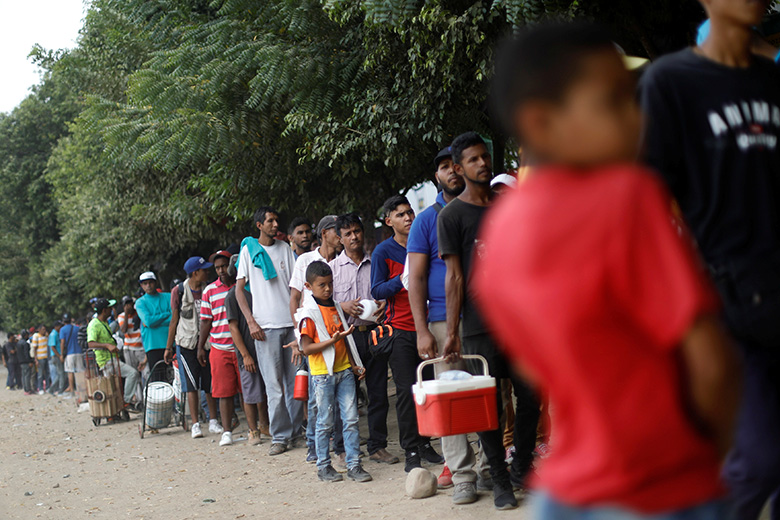| Risk experts consider Colombia in a good position to cope with a flood of refugees from the crisis in Venezuela |
The sheer scale of government spending and consumer-led domestic demand arising from a surge in population growth have put many of the country’s macro-fiscal indicators under strain, apart from economic growth, which is now accelerating.
The Venezuelan diaspora is rapidly rising as refugees pour over the border fleeing the political and economic crisis there.
The International Rescue Committee has indicated that at a rate of more than 4,000 per day, more than one million Venezuelans crossed the border in 2017/18, including 300,000 Colombians who were living there.
Under strain
As the flow continues, more people invariably mean higher consumer spending, boosting economic growth, but also putting welfare services and, by implication, fiscal management under strain.
Last year’s 2.7% GDP growth rate is expected to be improved upon. The IMF is predicting 3.6% for 2019, supported by a relaxed monetary policy with inflation now stabilizing.
However, with the government struggling to meet its fiscal rule, the deficit target for this year has been raised for a second time, to 2.7% of GDP from 2.4%, after being increased last year from 2.2%. The deficit for 2020 also has been raised from 2.2% to 2.3%.
IMF forecasts suggest external debt will rise to 48.7% of GDP, with the current-account deficit widening to 3.9% of GDP, fuelled by increased domestic demand drawing in imports.
Still, there is no sense of panic among risk experts, allowing for the fact Colombia has inherited an extraordinary crisis and is mostly in a favourable position to cope, not least with oil prices above $70 a barrel.
Euromoney’s survey shows Colombia, at investment grade, improving slightly, both this year and on a five-year trend basis, remaining well-anchored to 47th in tier three of the global rankings, sandwiched between Latvia and Botswana, both A-rated credits:
BBVA Research, a contributor to Euromoney’s risk survey, sees GDP growth of 3% this year – matching another contributor, ABN Amro – with the unemployment rate remaining high at 10.8%, and the current-account deficit rising to 4.3%, but with the fiscal deficit shrinking, even if now at a more gradual pace.
Meanwhile, the IMF is confident that Colombia’s external financing needs will be covered.
“The current account continues to be comfortably financed through foreign direct investment, as well as robust portfolio flows from a more diversified set of foreign investors,” it states in a recent report.
Privatization is another option the authorities can pursue to allow for the rising cost of healthcare and other welfare services, until the immigrants joining the workforce contribute more tax revenue.
A stake in Ecopetrol, the country’s largest petroleum company, is the more likely option, according to one Euromoney contributor who asked not to be named, although there are others, including ISA – the Medellin-based electricity company – among many other pies the state has its fingers in, should it go down that route.
Selling off its shares risks playing into the hands of leftists ahead of the next parliamentary elections due in 2022, which could add to political risks.
Broken promises
The peace process is fragile, and president Iván Duque’s approval ratings have shrunk as voters grow tired of broken promises to improve welfare and tackle corruption, with the crime situation worsening in cities, many believe.
Defence minister Guillermo Botero has recently faced a no-confidence vote concerning allegations that he covered up the murder of a former Farc guerrilla, and attorney-general Nelson Humberto Martinez has resigned in protest against a court denying the US an extradition request to put a former Farc leader on trial.
The political noise surrounding the peace process and other issues will undoubtedly continue.
Despite this, risk experts have upgraded many of Colombia’s economic and political risk indicators.
Policymaking is particularly well rewarded given the existence of the fiscal deficit rule, ensuring structural stability over time, while a credible inflation-targeting monetary policy framework has enabled exchange-rate flexibility to absorb shocks.
Banking-sector risks are also contained – in any event Colombia qualifies for a flexible credit line from the IMF, which authorities continue to treat as precautionary. It’s there if it’s needed.
Euromoney’s survey shows Colombia treading water: its risk scores may take a slight turn for the worse over the coming months if the fiscal picture deteriorates, but it will take a sizeable shift in risk perceptions for Colombia to slide into tier four.
NOTE: If you want to trade at forex professionally – trade with the help of our robot forex developed by our programmers.
Signal2forex review


 Signal2forex.com - Best Forex robots and signals
Signal2forex.com - Best Forex robots and signals




